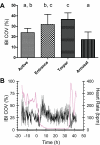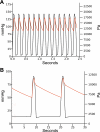Circulation and metabolic rates in a natural hibernator: an integrative physiological model
- PMID: 20844258
- PMCID: PMC3008751
- DOI: 10.1152/ajpregu.00273.2010
Circulation and metabolic rates in a natural hibernator: an integrative physiological model
Abstract
Small hibernating mammals show regular oscillations in their heart rate and body temperature throughout the winter. Long periods of torpor are abruptly interrupted by arousals with heart rates that rapidly increase from 5 beats/min to over 400 beats/min and body temperatures that increase by ∼30°C only to drop back into the hypothermic torpid state within hours. Surgically implanted transmitters were used to obtain high-resolution electrocardiogram and body temperature data from hibernating thirteen-lined ground squirrels (Spermophilus tridecemlineatus). These data were used to construct a model of the circulatory system to gain greater understanding of these rapid and extreme changes in physiology. Our model provides estimates of metabolic rates during the torpor-arousal cycles in different model compartments that would be difficult to measure directly. In the compartment that models the more metabolically active tissues and organs (heart, brain, liver, and brown adipose tissue) the peak metabolic rate occurs at a core body temperature of 19°C approximately midway through an arousal. The peak metabolic rate of the active tissues is nine times the normothermic rate after the arousal is complete. For the overall metabolic rate in all tissues, the peak-to-resting ratio is five. This value is high for a rodent, which provides evidence for the hypothesis that the arousal from torpor is limited by the capabilities of the cardiovascular system.
Figures






References
-
- Andrews MT. Advances in molecular biology of hibernation in mammals. Bioessays 29: 431–607 440, 2007 - PubMed
-
- Barnes BM. Freeze avoidance in a mammal: body temperatures below 0 degree C in an arctic hibernator. Science 244: 1593–1595, 1989 - PubMed
-
- Bassett DJ, Howley E. Limiting factors for maximum oxygen uptake and determinants of endurance performance. Med Sci Sports Exerc 32: 70–84, 2000 - PubMed
-
- Blake AS, Petley GW, Deakin CD. Effects of changes in packed cell volume on the specific heat capacity of blood: implications for studies measuring heat exchange in extracorporeal circuits. Br J Anaesth 84: 28–32, 2000 - PubMed
Publication types
MeSH terms
Grants and funding
LinkOut - more resources
Full Text Sources

